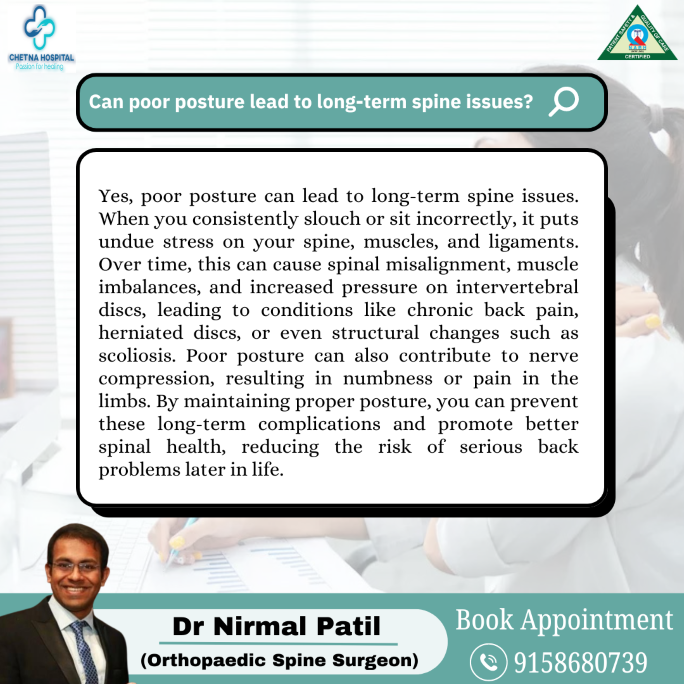In today’s fast-paced world, many people spend hours sitting in front of computers, slouching over smartphones, or adopting unhealthy postures while carrying out daily activities. Over time, poor posture can lead to a wide range of health problems, particularly concerning the spine. The spine is the central pillar of the body, responsible for providing support, stability, and flexibility. When posture is compromised, the spine bears an uneven load, which can result in long-term damage.
In this blog, we will explore how poor posture affects the spine, the potential long-term consequences, and how to prevent or reverse these issues.
Understanding the Anatomy of the Spine
The spine is a complex structure made up of 33 vertebrae that form the backbone. It is divided into five regions:
- Cervical Spine: The uppermost part of the spine (neck), consisting of seven vertebrae.
- Thoracic Spine: The mid-back region, consisting of 12 vertebrae.
- Lumbar Spine: The lower back, consisting of five vertebrae.
- Sacrum: Five fused vertebrae located at the base of the spine.
- Coccyx: The tailbone, made up of four fused vertebrae.
These vertebrae are cushioned by intervertebral discs, which act as shock absorbers and allow for movement. The spine is naturally curved to support weight and maintain balance. However, when posture is poor, these natural curves can become exaggerated or flattened, leading to strain on the vertebrae, muscles, and ligaments.
How Poor Posture Affects the Spine
- Increased Pressure on the SpineOne of the most immediate effects of poor posture is the uneven distribution of pressure across the spine. For example, slouching or hunching forward can place extra pressure on the lower back and neck, leading to strain and discomfort. Over time, this added pressure can cause wear and tear on the intervertebral discs and vertebrae, potentially leading to more serious conditions like disc degeneration or herniation.
- Spinal MisalignmentPoor posture can cause the spine to move out of its natural alignment. When you adopt a forward head posture (where the head juts forward), or you slouch excessively, the spine compensates by shifting its position to maintain balance. This can result in an unnatural curvature of the spine, often seen in conditions like kyphosis (excessive rounding of the upper back) or lordosis (exaggerated inward curve in the lower back).Over time, spinal misalignment can lead to chronic pain, stiffness, and limited mobility, making it harder to perform everyday activities.
- Muscle Imbalance and FatiguePoor posture forces certain muscles to work harder to maintain balance. For example, when slouching, the muscles in the back and neck become overstretched, while the muscles in the chest and shoulders become tight and shortened. This imbalance can lead to muscle fatigue, stiffness, and even spasms. Over time, the weakened muscles are unable to support the spine properly, leading to more stress on the vertebrae and discs.Additionally, prolonged poor posture can contribute to conditions like upper crossed syndrome, where tightness in the chest muscles and weakness in the neck and upper back muscles result in a hunched posture and neck pain.
- Increased Risk of Disc HerniationThe intervertebral discs act as cushions between the vertebrae, absorbing shock and allowing for flexibility. Poor posture, especially when sitting for long periods, can increase the pressure on these discs. In the case of forward head posture or prolonged slouching, this can lead to the discs becoming compressed.Over time, this excessive pressure can cause the discs to bulge or herniate, where the inner gel-like material of the disc pushes through the outer layer. Herniated discs can press on nearby nerves, causing pain, numbness, or weakness in the arms, legs, or back.
- Nerve CompressionPoor posture can also lead to nerve compression. For instance, when the spine is out of alignment, the spaces through which the nerves travel (the foramina) can narrow. This narrowing can pinch or compress the nerves, leading to conditions like sciatica, where the sciatic nerve is irritated, causing pain that radiates down the leg.Similarly, poor neck posture can compress nerves in the cervical spine, leading to symptoms such as tingling, numbness, or weakness in the arms and hands.
Long-Term Spine Issues Caused by Poor Posture
- Chronic Back and Neck PainOne of the most common long-term consequences of poor posture is chronic pain, particularly in the lower back and neck. Over time, the strain placed on muscles, joints, and discs due to poor posture can result in persistent discomfort. This chronic pain can significantly affect daily life, making it difficult to perform tasks, exercise, or even relax.Chronic back pain is often associated with prolonged sitting, slouching, or forward head posture, which increases stress on the lumbar spine and neck.
- Degenerative Disc DiseaseDegenerative disc disease is a condition where the intervertebral discs lose their cushioning ability over time, becoming thin and brittle. Poor posture accelerates the wear and tear of these discs by placing added pressure on them. As the discs degenerate, they may become more prone to herniation or bulging, leading to nerve compression and chronic pain.Degenerative disc disease can lead to limited mobility, stiffness, and chronic discomfort, particularly in the lower back and neck.
- Postural DeformitiesLong-term poor posture can lead to permanent structural changes in the spine, resulting in postural deformities. Two of the most common deformities associated with poor posture are kyphosis and lordosis.
- Kyphosis is characterized by an exaggerated forward curvature of the upper back, resulting in a hunched or rounded appearance. It can cause back pain, stiffness, and, in severe cases, breathing difficulties.
- Lordosis involves an excessive inward curve in the lower back, which can cause lower back pain, discomfort, and difficulty standing for extended periods.
- Reduced Mobility and FlexibilityPoor posture can lead to stiffness and reduced flexibility in the spine. When the muscles, joints, and ligaments surrounding the spine become accustomed to an unhealthy position, they can lose their ability to move freely. This reduced mobility can make it challenging to perform physical activities, exercise, or even complete daily tasks.Over time, a lack of movement can contribute to a sedentary lifestyle, increasing the risk of other health problems like obesity and cardiovascular disease.
Preventing and Correcting Poor Posture
The good news is that poor posture and its associated long-term spine issues can often be prevented or corrected with the right approach. Here are some tips to maintain proper posture and protect your spine health:
- Practice Mindful Posture
- Make a conscious effort to maintain good posture throughout the day. Whether standing, sitting, or walking, ensure that your head is aligned with your spine, your shoulders are relaxed, and your back is straight. Avoid slouching or leaning forward.
- Ergonomic Workspace Setup
- If you spend long hours sitting at a desk, invest in an ergonomic chair that provides lumbar support. Position your computer screen at eye level and keep your feet flat on the ground. Take frequent breaks to stand, stretch, and walk around to avoid prolonged sitting.
- Exercise Regularly
- Strengthening the muscles that support your spine is essential for maintaining good posture. Engage in exercises that target your core, back, and shoulders. Stretching exercises, such as yoga or Pilates, can also help improve flexibility and prevent stiffness.
- Use Supportive Devices
- For individuals with existing posture problems, supportive devices like lumbar rolls, ergonomic chairs, or posture correctors can provide the necessary alignment and support.
- Consult a Specialist
- If you are experiencing chronic pain or discomfort related to poor posture, consider consulting an orthopaedic spine specialist or physical therapist. They can assess your posture and recommend corrective exercises, therapies, or treatments to address underlying issues.
Conclusion
Poor posture may seem like a minor issue in the short term, but its long-term effects on the spine can be significant. Over time, improper alignment and muscle imbalances can lead to chronic pain, spinal degeneration, and postural deformities. However, with awareness and proactive measures, these issues can be prevented or managed effectively. By practicing good posture, maintaining an ergonomic environment, and staying active, you can protect your spine health and avoid the long-term consequences of poor posture.
For Consultation Contact us on 9158680739
Website – www.chetnahospital.co.in
Address – Chetna Hospital, Sambhajinagar, MIDC, G Block, Near Rotary Club, Chinchwad 411019
.
.
.
#pune#pcmc#chinchwad#hospital#medical#medicalservices#spinesurgeon#backspecialist#sciatica#sciaticnerve#sciaticapain#sciaticatreatment#spinesurgery#spinespecialist#spinedoctor#backpaindoctor#endoscopicspinesurgery#orthopaedicsurgeon#mistlifsurgery#cervicalpain#spinalcord#rediculopathy#backpainrelief#slippeddisc#spine#neckpain#spinalstenosis#lumberlordosis#backbonesurgery













